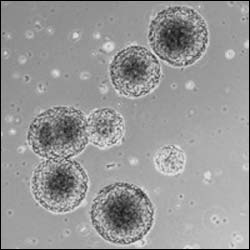Insulin-producing cells from brain cursors

Insulin-producing neurospheres. (Photo: Seung Kim et al.)
In a paper in this month’s freely-available online global health journal PLoS Medicine Seung Kim and colleagues from Stanford University suggest that one way of producing insulin-secreting pancreatic islet cells for future possible treatment of type I diabetes is to look beyond immature pancreatic cells and embryonic stem cells to other early cell types. Kim and colleagues took cells derived from brain which usually mature into neural cells, and exposed them to a series of signals that are known to drive pancreatic islet development. They were able to produce clusters of insulin-producing cells that responded to glucose out of the body.
When the cells were then transplanted into immunocompromised mice the cells could also be stimulated by glucose to produce human insulin. Future work will need to establish the long-term stability and safety of these cells and to work out how to scale up such a process to produce the much larger numbers of cells that would be needed for human treatment. However, the authors conclude that this technique “could serve as the basis for developing replacement islets from a wide range of human stem cells, including neural stem cells and ES cells.”
Media Contact
All latest news from the category: Life Sciences and Chemistry
Articles and reports from the Life Sciences and chemistry area deal with applied and basic research into modern biology, chemistry and human medicine.
Valuable information can be found on a range of life sciences fields including bacteriology, biochemistry, bionics, bioinformatics, biophysics, biotechnology, genetics, geobotany, human biology, marine biology, microbiology, molecular biology, cellular biology, zoology, bioinorganic chemistry, microchemistry and environmental chemistry.
Newest articles

High-energy-density aqueous battery based on halogen multi-electron transfer
Traditional non-aqueous lithium-ion batteries have a high energy density, but their safety is compromised due to the flammable organic electrolytes they utilize. Aqueous batteries use water as the solvent for…

First-ever combined heart pump and pig kidney transplant
…gives new hope to patient with terminal illness. Surgeons at NYU Langone Health performed the first-ever combined mechanical heart pump and gene-edited pig kidney transplant surgery in a 54-year-old woman…

Biophysics: Testing how well biomarkers work
LMU researchers have developed a method to determine how reliably target proteins can be labeled using super-resolution fluorescence microscopy. Modern microscopy techniques make it possible to examine the inner workings…





















